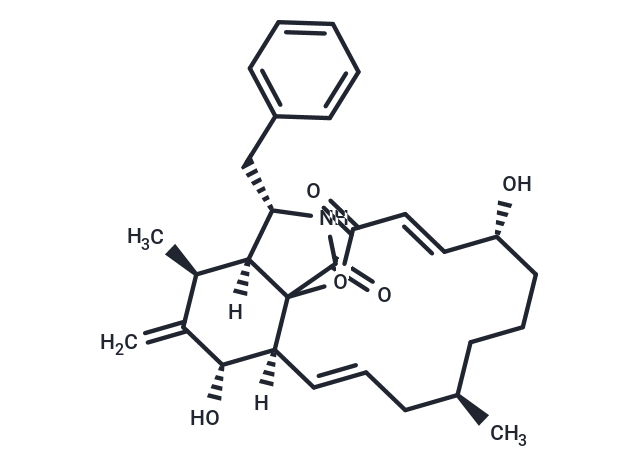Shopping Cart
- Remove All
 Your shopping cart is currently empty
Your shopping cart is currently empty

Cytochalasin B is a mycotoxin binding to the barbed end of actin filaments. It can disrupt the formation of actin polymers (Kd: 1.4-2.2 nM for F-actin).

| Pack Size | Price | Availability | Quantity |
|---|---|---|---|
| 1 mg | $228 | In Stock |
| Description | Cytochalasin B is a mycotoxin binding to the barbed end of actin filaments. It can disrupt the formation of actin polymers (Kd: 1.4-2.2 nM for F-actin). |
| Targets&IC50 | F-actin (Mg2+/K+):1.4 nM (Kd), F-actin (Mg2+):2.2 nM (Kd) |
| In vitro | Cytochalasin B is a cell-permeable mycotoxin that binds to the barbed end of actin filaments, inhibiting their elongation and shortening, with Kds of 2.2 nM and 1.4 nM for F-actin in the presence of MgCl2 (2 mM) or MgCl2 (2 mM) plus KCl, respectively [1]. At 6 μM, it increases the myofibrillar fragmentation index by intensively breaking myofibrillar proteins into short segments and accelerates actin filament disruption and F-actin to G-actin transformation, thereby reducing F-actin content and significantly increasing G-actin bands during postmortem conditioning [2]. Cytochalasin B exhibits inhibitory effects on multiple murine cancer cell lines, with IC50s of 2.56 μM (M109c), 10.46 μM (B16BL6), 105.5 μM (P388/ADR), 51.9 μM (P388/S) and IC80s of 12.23 μM (M109c), 44.86 μM (B16BL6), 188.4 μM (P388/ADR), 84.1 μM (P388/S) after 3-hour treatment, and IC50s of 0.25 μM (M109c), 0.37 μM (B16F10), 0.87 μM (B16BL6), and IC80s of 0.75 μM (M109c), 1.21 μM (B16F10) after a 4-day treatment [3]. |
| In vivo | Cytochalasin B, administered intraperitoneally at doses of 10, 25, and 50 mg/kg, enhances the lifespan of Balb/c mice afflicted with P388/ADR leukemias in a dose-dependent manner. Specifically, a 50 mg/kg dose of Cytochalasin B results in a 10% increase in long-term survival rates for mice with multidrug-resistant P388/ADR leukemia, and a 40% increase in long-term survival for those with the drug-sensitive P388/S variant [3]. |
| Cell Research | The attached cell lines M109c, B16BL6, and B16F10 are seeded at 1 to 4?×?10^4 cells/mL in 2 mL volumes in 24-well culture plates 1 day prior to treatment with Cytochalasin B. The suspension culture of P388/ADR cells is seeded at 5?×?10^4 cells/mL and allowed to grow overnight before Cytochalasin B treatment. Cells are treated with Cytochalasin B for 3 h, as well as 2, 3, or 4 days. In the case of continuous exposure for 2, 3, or 4 days, attached cells are trypsinized and counted with a hemacytometer. Leukemia cell suspensions are counted with a Coulter Counter. In the case of short-term exposure, cells are washed twice with fresh medium, then trypsinized (except for P388/ADR cells), reseeded, and allowed to regrow for 3 days, at which time they are counted. Growth results are calculated as the number of cells generated above the seeding density compared to the untreated control cells and graphically presented as a percent of control increase [3]. |
| Animal Research | For chemotherapy testing, Balb/c mice under isoflurane anesthesia are challenged with 2?×?10^5 trypan blue negative P388/S or P388/ADR cells subcutaneously (s.c.) in a volume of 200 μL. Untreated mice are kept in order to determine the lethality of the challenge without chemotherapeutic intervention. Long-term survival is defined as challenged mice that survive the duration of the observation period. Cytochalasins B and D are prepared in suspension form in 2 % carboxymethyl cellulose 1 % tween 20 (CMC/Tw) for intraperitoneal (i.p.) administration. The congeners or the vehicle are administered to leukemia-challenged mice on Days 1-8 following the initial challenge [2]. |
| Alias | Phomin |
| Molecular Weight | 479.61 |
| Formula | C29H37NO5 |
| Cas No. | 14930-96-2 |
| Smiles | [H][C@]12[C@H](Cc3ccccc3)NC(=O)C11OC(=O)\C=C\[C@H](O)CCC[C@@H](C)C\C=C\[C@@]1([H])[C@H](O)C(=C)[C@H]2C |
| Relative Density. | 1.2 g/cm3 |
| Storage | store at low temperature,keep away from direct sunlight | Powder: -20°C for 3 years | In solvent: -80°C for 1 year | Shipping with blue ice. | |||||||||||||||||||||||||
| Solubility Information | Ethanol: 20 mg/mL (41.7 mM), Sonication is recommended. DMSO: 20 mg/mL (41.7 mM), Sonication is recommended. | |||||||||||||||||||||||||
Solution Preparation Table | ||||||||||||||||||||||||||
Ethanol/DMSO
| ||||||||||||||||||||||||||

Copyright © 2015-2025 TargetMol Chemicals Inc. All Rights Reserved.